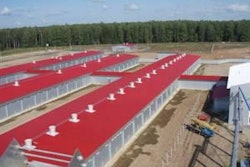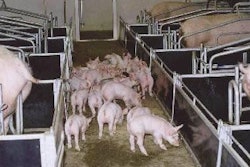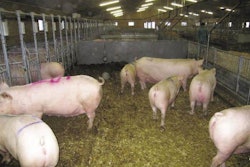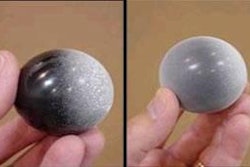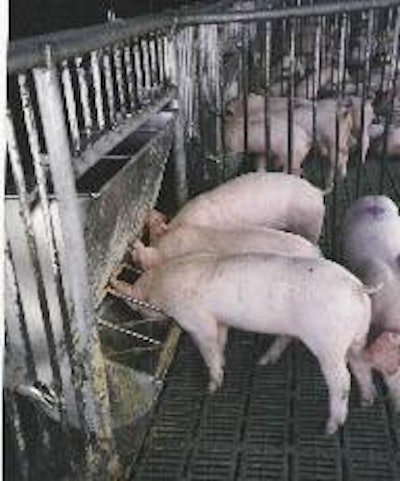
When feed is as expensive as it is today you have to be extra careful how you use it. The last thing you can afford is waste — whether from a spillage of meal through the slats of the floor or from substandard efficiency of utilisation.
As producers attending an Irish conference were reminded recently, the biggest impact on your feed cost and profit margin may be from the feeders or troughs in pig finishing houses.
Michael McKeon of Ireland's farm development agency Teagasc commented that although pig producers exercised no influence on world grain markets, they had complete control over how expensive grains were utilised at their production site. A finisher feeder would generally be well down the list in terms of improvements or technical adjustments that could be made in the light of rising feed costs, he added. But regarding it as too simple or basic to be worth close attention would be a critical and costly mistake.
The finishing period contributes 60% of total feed costs and 40% of all production costs, said Mr McKeon. So you will need a feeder for this stage that safeguards feed efficiency. In Ireland in 2007, an increase in finisher feed wastage as small as 1% would still cost €4700 per year on a breeding-finishing unit of 500 sows.
Table 1 sets out the sample calculation he offered for the quantity of feed that passes through a typical feeder during the course of its working life and what this would mean on an average 500-sow unit based on 20 finishing pigs per feeder per pen. The volume shows the critical effect that feeder selection and maintenance can have on feed efficiency, he commented. Yet the type of feeder is often ignored as a consideration when planning a new finishing house. Far more priority is given on most units to aspects such as flooring or ventilation than to how the feed will be distributed.
The selection of a feeder is often decided casually, Mr McKeon indicated. Usually it is chosen as the cheapest that can be found. Perhaps a similar type is in use elsewhere on the farm and is lasting well. Or, it seemed to be working adequately when seen on another unit. A third common occurrence is that it was the only type the equipment supplier could provide. More reliable information is rarely sought.
"Even though a 10% difference in feed wastage can have a huge cost, nobody appears to ask which feeder has been shown by independent trials to be the most efficient. If feed costs €250 per ton, about €36 500 worth will pass through the feeder in its lifetime. But people will choose a €160 feeder rather than one costing €180 because it saves €20!"
Do not buy a feeder without independent trial results, he urged the participants at the Teagasc annual conference. A number of trials in the USA have shown that there is a considerable difference between feeder types on the market for the amount of feed they can waste. In general, wet-dry feeders have less wastage then dry feeders but there are considerable variations even within the wet-dry feeder category. Many have a solid pad in front of the feeding place to reduce wear on the slatted floor. Evidence of feed on this solid area has been shown to indicate a high level of wastage.
It all adds up to money. Table 2 from Mr McKeon's presentation shows how the amount wasted from a feeder can affect the unit's feed cost per kilogram of pig produced and the savings per pig possible by reducing this wastage. Evidently, in this example, the difference between an efficient and inefficient feeder could amount to 57 Euro cents for every kilogram of carcase weight produced.
Take care with adjustment
No matter how well a feeder is designed it will not operate efficiently if not properly adjusted, Michael McKeon commented. The vast majority of single-space feeders receive no further adjustment after they have been installed. Frequently a build-up of feed can be seen in the bottom of the feeder and in front of it, a clear sign that the device is poorly adjusted. Visible evidence of this sort would not occur unless the quantity wasted was considerable, amounting to at least 12%.
The water nipple in a wet-dry feeder may also be leaking. This will add to the wastage factor, as feed falling off the flat shelf below the downpipe from the hopper is washed away and down the slats. To cut the amount leaving the shelf uneaten, Mr McKeon advised reducing the feed opening when a pen is filled, then increasing it gradually over the following weeks as the pigs grow bigger.
"As a rule of thumb, approximately 50% of the feeder shelf should be visible and there should be little or no feed around the water nipple. Leaking nipples must be fixed immediately since they can have a huge effect on the volume of manure produced as well as on feed wastage."
The position of the feeder in the pen will affect how well the pigs use it and how often it is adjusted. Ideally a single-space feeder should be placed away from pen corners, he said, with the opening at a 90° angle to the pen wall and preferably within reach of the passageway to aid easy adjustment.
"Angled double wet-dry feeders (where the twin openings are at a 90° angle to each other) appear to work better than side-by-side or back-to-back feeders, as the pigs appear to dirty the angled feeder less. Feed efficiency has been shown to deteriorate by 4% in side-by-side feeders then when compared to corner or back-to-back feeders."
Other points to consider from this presentation: Replace damaged or worn-out feeders immediately (the potential savings will pay for the new feeder within 6 months) and look at possibly choosing a wet-dry type as the replacement for a conventional dry feeder — research having shown that such a change can increase average daily gain by 5% and reduce the manure produced by 40%.
"There is also an optimum for the feed in the feeder. In general, feed efficiency should improve by 1.2 % for every 100-micron reduction in particle size. But too fine a particle size may lead to an increased risk of gastric ulcers and of feeder bridging. The recommendation in Denmark is to have 60% of particles under 1mm in diameter, while an 80% target may be realistic for some farms.
"Screens and hammers should be checked at least every 6 months, because wear over time will adversely increase the feed particle size. Units buying commercial feed could examine using pellets instead of meal. It may seem ridiculous to be suggesting this in the light of today's exorbitant feed prices, but that is exactly the time when pelleting can give a return. Pelleting a diet can improve feed efficiency by 5-8% and average daily gain by 3% due to less spillage. Research in Northern Ireland found a feed efficiency improvement of 6% from using pellets instead of meal in wet-dry feeders. This improvement alone would cover a pelleting cost of €15 per ton, even without accounting for the average daily gain benefit." PIGI


